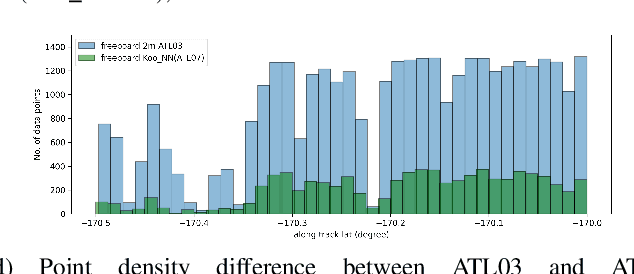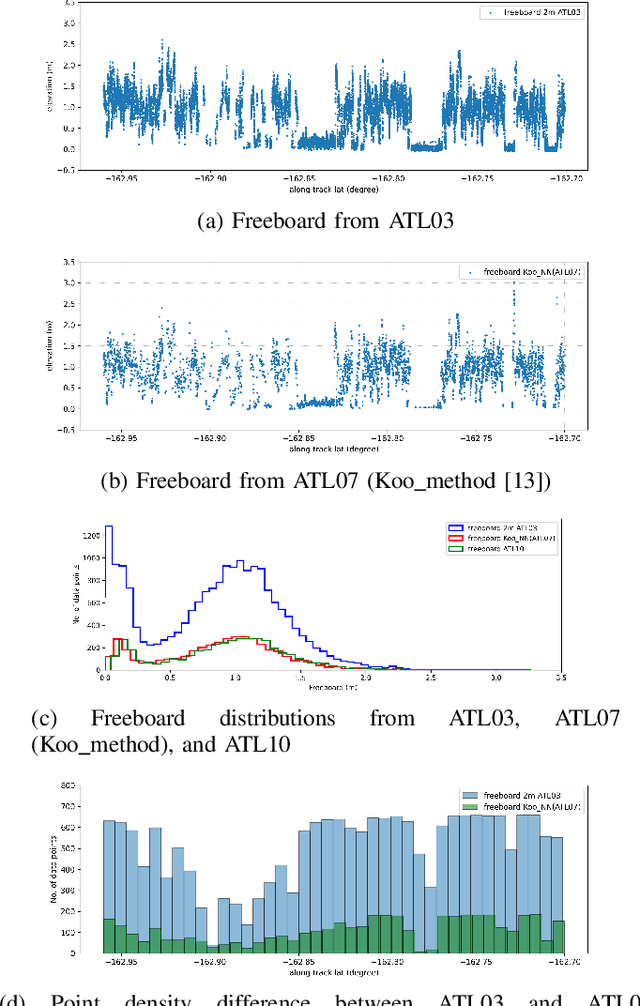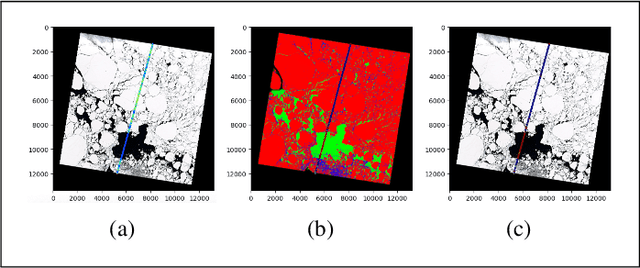Younghyun Koo
Scalable Higher Resolution Polar Sea Ice Classification and Freeboard Calculation from ICESat-2 ATL03 Data
Feb 04, 2025



Abstract:ICESat-2 (IS2) by NASA is an Earth-observing satellite that measures high-resolution surface elevation. The IS2's ATL07 and ATL10 sea ice elevation and freeboard products of 10m-200m segments which aggregated 150 signal photons from the raw ATL03 (geolocated photon) data. These aggregated products can potentially overestimate local sea surface height, thus underestimating the calculations of freeboard (sea ice height above sea surface). To achieve a higher resolution of sea surface height and freeboard information, in this work we utilize a 2m window to resample the ATL03 data. Then, we classify these 2m segments into thick sea ice, thin ice, and open water using deep learning methods (Long short-term memory and Multi-layer perceptron models). To obtain labeled training data for our deep learning models, we use segmented Sentinel-2 (S2) multi-spectral imagery overlapping with IS2 tracks in space and time to auto-label IS2 data, followed by some manual corrections in the regions of transition between different ice/water types or cloudy regions. We employ a parallel workflow for this auto-labeling using PySpark to scale, and we achieve 9-fold data loading and 16.25-fold map-reduce speedup. To train our models, we employ a Horovod-based distributed deep-learning workflow on a DGX A100 8 GPU cluster, achieving a 7.25-fold speedup. Next, we calculate the local sea surface heights based on the open water segments. Finally, we scale the freeboard calculation using the derived local sea level and achieve 8.54-fold data loading and 15.7-fold map-reduce speedup. Compared with the ATL07 (local sea level) and ATL10 (freeboard) data products, our results show higher resolutions and accuracy (96.56%).
Graph Neural Network as Computationally Efficient Emulator of Ice-sheet and Sea-level System Model (ISSM)
Jun 26, 2024Abstract:The Ice-sheet and Sea-level System Model (ISSM) provides solutions for Stokes equations relevant to ice sheet dynamics by employing finite element and fine mesh adaption. However, since its finite element method is compatible only with Central Processing Units (CPU), the ISSM has limits on further economizing computational time. Thus, by taking advantage of Graphics Processing Units (GPUs), we design a graph convolutional network (GCN) as a fast emulator for ISSM. The GCN is trained and tested using the 20-year transient ISSM simulations in the Pine Island Glacier (PIG). The GCN reproduces ice thickness and velocity with a correlation coefficient greater than 0.998, outperforming the traditional convolutional neural network (CNN). Additionally, GCN shows 34 times faster computational speed than the CPU-based ISSM modeling. The GPU-based GCN emulator allows us to predict how the PIG will change in the future under different melting rate scenarios with high fidelity and much faster computational time.
Graph Neural Networks for Emulation of Finite-Element Ice Dynamics in Greenland and Antarctic Ice Sheets
Jun 26, 2024Abstract:Although numerical models provide accurate solutions for ice sheet dynamics based on physics laws, they accompany intensified computational demands to solve partial differential equations. In recent years, convolutional neural networks (CNNs) have been widely used as statistical emulators for those numerical models. However, since CNNs operate on regular grids, they cannot represent the refined meshes and computational efficiency of finite-element numerical models. Therefore, instead of CNNs, this study adopts an equivariant graph convolutional network (EGCN) as an emulator for the ice sheet dynamics modeling. EGCN reproduces ice thickness and velocity changes in the Helheim Glacier, Greenland, and Pine Island Glacier, Antarctica, with 260 times and 44 times faster computation time, respectively. Compared to the traditional CNN and graph convolutional network, EGCN shows outstanding accuracy in thickness prediction near fast ice streams by preserving the equivariance to the translation and rotation of graphs.
Graph Neural Networks as Fast and High-fidelity Emulators for Finite-Element Ice Sheet Modeling
Feb 07, 2024Abstract:Although the finite element approach of the Ice-sheet and Sea-level System Model (ISSM) solves ice dynamics problems governed by Stokes equations quickly and accurately, such numerical modeling requires intensive computation on central processing units (CPU). In this study, we develop graph neural networks (GNN) as fast surrogate models to preserve the finite element structure of ISSM. Using the 20-year transient simulations in the Pine Island Glacier (PIG), we train and test three GNNs: graph convolutional network (GCN), graph attention network (GAT), and equivariant graph convolutional network (EGCN). These GNNs reproduce ice thickness and velocity with better accuracy than the classic convolutional neural network (CNN) and multi-layer perception (MLP). In particular, GNNs successfully capture the ice mass loss and acceleration induced by higher basal melting rates in the PIG. When our GNN emulators are implemented on graphic processing units (GPUs), they show up to 50 times faster computational time than the CPU-based ISSM simulation.
Multi-task Deep Convolutional Network to Predict Sea Ice Concentration and Drift in the Arctic Ocean
Oct 31, 2023Abstract:Forecasting sea ice concentration (SIC) and sea ice drift (SID) in the Arctic Ocean is of great significance as the Arctic environment has been changed by the recent warming climate. Given that physical sea ice models require high computational costs with complex parameterization, deep learning techniques can effectively replace the physical model and improve the performance of sea ice prediction. This study proposes a novel multi-task fully conventional network architecture named hierarchical information-sharing U-net (HIS-Unet) to predict daily SIC and SID. Instead of learning SIC and SID separately at each branch, we allow the SIC and SID layers to share their information and assist each other's prediction through the weighting attention modules (WAMs). Consequently, our HIS-Unet outperforms other statistical approaches, sea ice physical models, and neural networks without such information-sharing units. The improvement of HIS-Unet is obvious both for SIC and SID prediction when and where sea ice conditions change seasonally, which implies that the information sharing through WAMs allows the model to learn the sudden changes of SIC and SID. The weight values of the WAMs imply that SIC information plays a more critical role in SID prediction, compared to that of SID information in SIC prediction, and information sharing is more active in sea ice edges (seasonal sea ice) than in the central Arctic (multi-year sea ice).
 Add to Chrome
Add to Chrome Add to Firefox
Add to Firefox Add to Edge
Add to Edge